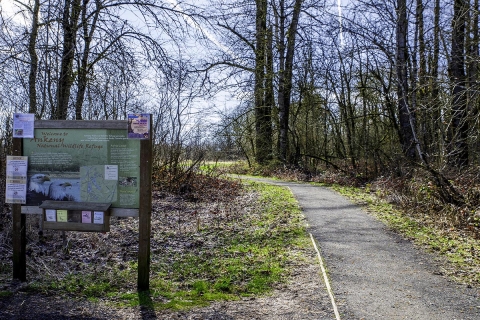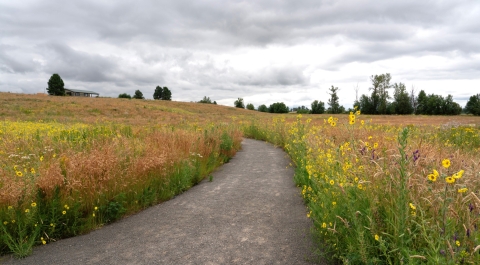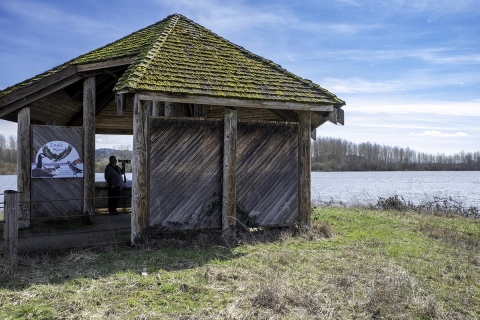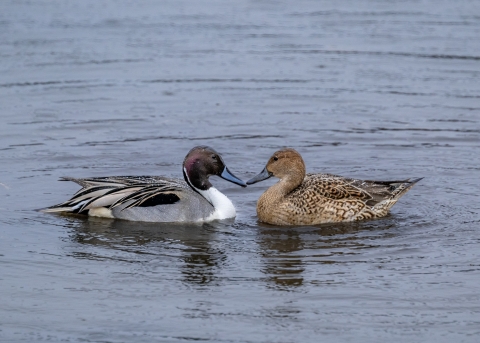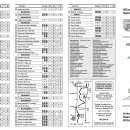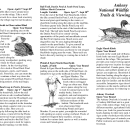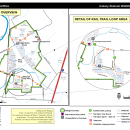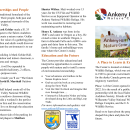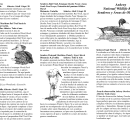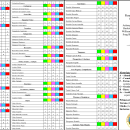Visit Us
National wildlife refuges offer us all a chance to unplug from the stresses of daily life and reconnect with our natural surroundings.
Ankeny National Wildlife Refuge provides a plethora of different public use activities. From hiking to nature photography, there is plenty to do, and just off Interstate-5 too!
Wildlife observation opportunities abound for a variety of species. From the croaking Pacific chorus frog, to the cackling acorn woodpecker, there is always something new to discover.
All of Ankeny's trails, boardwalks, and kiosks provide family-friendly wildlife viewing areas. The refuge has few hills, so all trails have very little elevation-gain, offering easy walks without losing any of the nature-experience opportunities.
Refuge Access
The refuge is open from dawn to dusk. The refuge is bordered by Ankeny Hill Road, Buena Vista Road, and Wintel Road to the north, west and south respectively, and visitors can access refuge trails and/or viewing areas from each. Parking is allowed in designated parking areas only. No overnight parking is allowed on the refuge.
Hiking
Hiking is allowed in all areas open to the public. Wildlife observation and photography are encouraged. Please stay out of closed areas to minimize disturbance to plants and animals. Bicycling and running are allowed only on designated public access routes. These activities are not allowed on trails or roads closed to public vehicles.
General Regulations
Other prohibitions on the refuge are the collection of plants, animals, minerals, antlers and artifacts. Leashed dogs are permitted in designated parking areas only. All dogs and pets are prohibited on refuge trails and roads.
Where We are Located
Ankeny NWR can be found off of Interstate 5, 12 miles south of Salem, Oregon or 10 miles north of Albany, Oregon; take the Ankeny Hill Exit (243).
For questions about recreation, please contact the refuge complex office at (541) 757-7236 during normal office hours
Activities
Things to Do
If you have 15 minutes....
- Stop by the Ankeny Hill Nature Center for some information and grab an English or Spanish trails brochure. Take a look at the hummingbird feeder and native plants in the Pollinator Patch to observe Anna's and Rufous hummingbirds. In the Winter enjoy the view of Peregrine Marsh from the David B. Marshall Outdoor Classroom to see Mallards, a flock of dusky Canada goose, Red-winged blackbirds, and other waterfowl.
If you have one hour....
- Go on a hike or go birding! Ankeny has several miles of trails and is one of the most popular locations for birders to see migratory birds, especially in the Spring and Winter.
If you have half a day or more....
- Drive around the Refuge and explore the trails and viewpoints. The Refuge is bordered by Ankeny Hill Road, Wintel Road, and Buena Vista Road, making it easy for folks to explore the different native habitats on the Refuge. See the map to plan your adventure!
Know Before You Go
Prepare for your visit by packing supplies in a bag. The following suggested items will keep you comfortable and safe when you’re outside:
- Jacket
- Full water bottle
- Sunscreen
- Hat
- Closed-toe shoes
- Cell phone
You might also want:
- Backpack
- Bug spray
- Personal medications
- Binoculars
- Portable first aid kit
- Sunglasses
Ankeny National Wildlife Refuge provides a plethora of different public use activities. From hiking to nature photography, there is plenty to do, and just off Interstate-5 too!
Wildlife Viewing
If you enjoy getting outdoors and looking for wildlife, consider a visit to your nearest national wildlife refuge national wildlife refuge
A national wildlife refuge is typically a contiguous area of land and water managed by the U.S. Fish and Wildlife Service for the conservation and, where appropriate, restoration of fish, wildlife and plant resources and their habitats for the benefit of present and future generations of Americans.
Learn more about national wildlife refuge ! At Ankeny wildlife viewing opportunities range from the stately great blue heron, to chittering western gray squirrels and kreck-ek-ing pacific chorus frogs.
Interpretation
For interpretive experiences at Ankeny NWR, check out Ankeny Hill Nature Center, the Eagle Marsh Kiosk, Rail Trail Boardwalk, or the Pintail & Egret Marsh Boardwalk.
Ankeny Hill Nature Center (AHNC)
Did you know Ankeny National Wildlife Refuge partners with the Salem Audubon Society and the Friends of the WVNWRC to operate a Nature Center at Ankeny Hill? The Ankeny Hill Nature Center is 25 acres and includes two accessible trails, a Nature Explore Area, education nodes, Oak Overlook, Volunteer Basecamp and that's just the 1st Phase! The building, Gehlar Hall, is an indoor and outdoor classroom. In the summer of 2024, the Dave Marshall Outdoor Classroom wias built. The Ankeny Hill Nature Center is dedicated to being as inclusive and accessible as possible. Visit anytime from dawn to dusk! It's always free.
Recreational Opportunities
With the passage of the National Wildlife Refuge System Improvement Act in 1997, six wildlife-dependent recreational activities are often managed on refuges as long as they are determined to be compatible, legitimate and appropriate public uses of the refuge. Wildlife observation, photography, environmental education, and interpretation are often referred to as the "big six". Ankeny offers four of the big six, including environmental education and interpretation programs, great wildlife viewing and photography opportunities.
Trails
Ankeny has both year-round and seasonal trails. Seasonal trails are specified in their description and are open from April 1st - September 30th.
Download Our Trails Brochure: English / Spanish
Here is a refuge map to help you find trailheads and other viewing areas! Ankeny NWR Map
Visit our homepage to view any current alerts, including trail closures.
Please note, dogs are not allowed on any refuge trails.
Trails, Viewpoints & Boardwalks
Trail | Image and/or Video | Description | Additional Information |
Pintail-Egret Marsh Boardwalk Trail(Year-round) | Trailhead location: Pintail & Egret Marsh Boardwalk begins at a parking area on the north side of Wintel Road. An interpretive sign at the trailhead describes the Marshes.Trail description: The boardwalk follows Bashaw Creek where red-legged frogs are often seen. Make sure to pause along the way to look for animal tracks in the muddy banks, listen for songbirds, and read interpretive signs to learn more about the different residents of this habitat. The boardwalk ends at an observation blind overlook Pintail and Egret Marshes. If you are quiet, you might be rewarded with spotting an osprey soaring overhead. Flocks of waterfowl frequent these marshes, so keep a lookout for various duck species as well as Tundra Swans and Canada geese. Check out the eBird Hotspot to know which birds are being recorded at the trail.View TrailNote: Boardwalk can be slippery when wet or icy. Please use caution during winter months. |
| |
Rail Trail to Observation Blind(Year-round) | Video: Spanish/Español | Trailhead location: The start of Rail Trail is at a parking lot on the south side of Wintel Road. Interpretive signs at the trailhead provide information about the refuge. From the Rail Trail parking lot, follow the gravel trail to the boardwalk.Trail description: The boardwalk will take you through seasonally flooded ash woodlands. Stop at benches and interpretive panels along the way to look for Downy Woodpeckers pecking away at the branches or listen for Black-capped Chickadees in the shrubs. At the viewing blind, make sure to stop for a look at Wood Duck Pond where Hooded Mergansers, Great Egrets, and Canada geese are often seen. From here, you can return the way you came or continue a short way down the boardwalk as it wraps around Wood Duck Pond to a dike where the loop portions of the trail begin. Check out the eBird Hotspot to know which birds are being recorded at the trail.Note: Boardwalk can be slippery when wet or icy. Please use caution during winter months.View Trail |
|
Eagle Marsh Trail(Seasonal - April 1st to September 30th) | Video: Spanish/Español | Trailhead location: Eagle marsh trail is located on the south side of Buena Vista Road. The kiosk viewing area is open year-round and the trail is seasonal.View Trail |
|
Ankeny Hill Nature Center Big Loop and Little Loop Trails(Year-round) | Video: Spanish/Español | Trailhead location: The Big Loop trail can be accessed on the North or South side of Gehlar Hall from Ankeny Hill Road. The Little Loop trail is located on the right side of the path from the North end of Gehlar Hall.Trail description: Explore the accessible trails at the Ankeny Hill Nature Center and see all it has to offer such as the Nature Explore Area, Pollinator Patch, bridges, tunnels, David B. Marshall Outdoor Classroom, and several education nodes along the path. Check out the eBird Hotspot to know which birds are being recorded at the trails. |
|
Eagle Marsh Observation Blind(Year-round) | Viewpoint location: The Eagle Marsh Observation Blind parking lot can be accessed off Buena Vista Road.Viewpoint description: Stop by the Eagle Marsh Viewing Blind on the south side of Buena Vista Rd for incredible wildlife viewing without hiking. This large marsh hosts Canada geese, cinnamon teals, and bald eagles. Interpretive signs offer insights into seasonal activity. Check out the eBird Hotspot to know which birds are being recorded. |
| |
Pintail Marsh Overlook(Year-round) | Viewpoint location: The Pintail Marsh Overlook parking lot can be accessed off Wintel Road.Viewpoint description: Visit the Pintail Marsh Overlook for incredible wildlife viewing. Park at the Pintail Marsh Parking Lot on the North side of Wintel Road and spot bald eagles, white pelicans, and diverse duck species. Every season brings new wildlife to discover in this scenic marsh setting. Check out the eBird Hotspot to know which birds are being recorded. |
|
The Dike Trails
Length: Variable
Open: April 1st-September 30th
Seasonally accessible dikes weave around most ponds and marshes on the refuge. Take a stroll down one of these paths for a closer look at activity on the water. See the refuge map for trail locations.
Rail Trail Boardwalk to Observation Blind
Length (one-way): .75 mile
Open: Year Round
Difficulty: Easy
Type of trail: Out and Back
Trailhead location: The start of Rail Trail is at a parking lot on the south side of Wintel Road. Interpretive signs at the trailhead provide information about the refuge. From the Rail Trail parking lot, follow the gravel trail to the boardwalk.
Trail description: The boardwalk will take you through seasonally flooded ash woodlands. Stop at benches and interpretive panels along the way to look for Downy Woodpeckers pecking away at the branches or listen for Black-capped Chickadees in the shrubs. At the viewing blind, make sure to stop for a look at Wood Duck Pond where Hooded Mergansers, Great Egrets, and Canada geese are often seen. From here, you can return the way you came or continue a short way down the boardwalk as it wraps around Wood Duck Pond to a dike where the loop portions of the trail begin.
Note: Boardwalk can be slippery when wet or icy. Please use caution during winter months.
Rail Trail, Woodland Loop & Prairie Extension
Length: .5 to 1 mile
Open: April 1st-September 30th
From the end of the boardwalk, follow the trail across the dike and into an oak woodland habitat. An excellent summertime trail, the Woodland Loop is shaded under the forest canopy and provides opportunities to listen for songbirds in the branches above. After hiking about a quarter mile you come out of the forest onto a dike. Here you can complete the Loop by following the dike back to the boardwalk junction or turn left for the Prairie Extension. This mown trail wraps around an open prairie for a half mile and back to the Rail Trail parking lot. This is a great spot to look for raptors such as northern harrier hunting over the fields.
Rail Trail, Dunlin Pond & South Pond Loops, Killdeer Marsh Extension
Length: Variable
Open: April 1st-September 30th
From the end of the Rail Trail Boardwalk, follow the dike around Dunlin Pond. Look for great blue herons and great egret hunting in the waters, or shorebirds feeding along the pond-edges on the mudflats. The three-quarter-mile Dunlin Pond Loop will connect you to the start of the boardwalk on Rail Trail. The half mile South Pond Loop leaves Dunlin Pond Trail to extend viewing opportunities of the ponds and marshlands around the Rail Trail riparian riparian
Definition of riparian habitat or riparian areas.
Learn more about riparian area. Marsh wrens and dragonflies may be seen zipping through the cattails on the pond banks. To give yourself an extra 0.45 mile of wetland trails, follow the Killdeer Marsh Extension and listen for red-winged blackbirds singing near the water. These trails are best in the early morning or evening due to lack of shade.
Eagle Marsh Viewing Blind
Open: Year Round
Viewpoint description: Stop by the Eagle Marsh Viewing Blind on the south side of Buena Vista Rd for incredible wildlife viewing without hiking. This large marsh hosts Canada geese, cinnamon teals, and bald eagles. Interpretive signs offer insights into seasonal activity.
Eagle Marsh Berm Trails
Distance: Varies
Open: April 1st - September 30th
Difficulty: Easy
Type of trail: Loops
Trail description: The berm roads on either side of the parking area are open for hiking.
Pintail Marsh Overlook
Open: Year Round
Viewpoint description: Visit the Pintail Marsh Overlook for incredible wildlife viewing. Park at the Pintail Marsh Parking Lot on the North side of Wintel Road and spot bald eagles, white pelicans, and diverse duck species. Every season brings new wildlife to discover in this scenic marsh setting.
Pintail Marsh Berm Trails
Distance: Varies
Open: April 1st - September 30th
Difficulty: Easy
Type of trail: Loop
Trail description: The berm road on the East side of the parking area is open for hiking.
Ankeny Hill Nature Center Little Loop & Big Loop Trails
Distance: 0.71 miles
Open: Year Round
Difficulty: Easy
Type of trail: Loop
Surface Type: Dirt or gravel with some plants.
Trail description: The Little Loop goes around the Nature Explore Area and passes by the Oak Overlook and Pollinator Patch. The Big Loop visits riparian habitats, multiple education nodes, a storywalk, and the David B. Marshall outdoor classroom by Peregrine Marsh before returning to Gehlar hall.
Pintail & Egret Marsh Boardwalk
Length: .25 mile
Open: Year Round
Trailhead location: Pintail & Egret Marsh Boardwalk begins at a parking area on the north side of Wintel Road. An interpretive sign at the trailhead describes the Marshes.
Trail description: The boardwalk follows Bashaw Creek where red-legged frogs are often seen. Make sure to pause along the way to look for animal tracks in the muddy banks, listen for songbirds, and read interpretive signs to learn more about the different residents of this habitat. The boardwalk ends at an observation blind overlook Pintail and Egret Marshes. If you are quiet, you might be rewarded with spotting an osprey soaring overhead. Flocks of waterfowl frequent these marshes, so keep a lookout for various duck species as well as Tundra Swans and Canada geese.
Note: Boardwalk can be slippery when wet or icy. Please use caution during winter months.
Related Documents
Here you will find a variety of Refuge maps and resources.
Other Facilities in the Complex
Ankeny National Wildlife Refuge is managed as part of the Willamette Valley National Wildlife Refuge Complex. A National Wildlife Refuge Complex is an administrative grouping of two or more refuges, wildlife management areas or other refuge conservation areas that are primarily managed from a central location. Refuges are grouped because they occur in a similar ecological region and have a related purpose and management needs. These refuges for example, were created in the 1960s specifically for the habitat they provide for the dusky Canada geese in the winter.
The Willamette Valley National Wildlife Refuge Complex consists of three refuges: William L. Finley NWR and its additional Snag Boat Bend Unit, Ankeny NWR and Baskett Slough NWR.
Rules and Policies
Know Before You Go
The refuge rules make you a wonderful visitor to wildlife's home and enable you to have some incredible wildlife interactions.
Activities not described in this section OR the activities section(s) are prohibited on the Refuge. To inquire about regulations or Refuge operations, contact the Refuge staff.
There are many fun, interesting, and educational activities you can do at Ankeny. Keep in mind, if an activity is not wildlife related and doesn't help in the protection or understanding of wildlife or their habitat, there are probably refuge rules governing the activity. Please check with refuge management before participating in an activity that could harm the environment or yourself.
We have several rules and regulations in place to help with the protection of our wildlife and their habitats, as well as for the enjoyment of all visitors to the refuge. Ankeny National Wildlife Refuge is actively patrolled by Federal Wildlife Officers. All federal, state, and local laws and regulations are applicable on refuge system lands and waters.
Cell phone reception in the refuge is extremely limited. Don’t assume it will work! Make a safety plan before you go and always let someone know where you will be and when you plan to return.
Refuge phone number: (541) 757-7236
Emergency Phone Number: 911
Locations
Refuge Access
The refuge is open from sunrise to sunset. The refuge is bordered by Ankeny Hill Road, Buena Vista Road, and Wintel Road to the north, west and south respectively, and visitors can access refuge trails and/or viewing areas from each. Parking is allowed in designated parking areas only. No overnight parking is allowed on the refuge.

